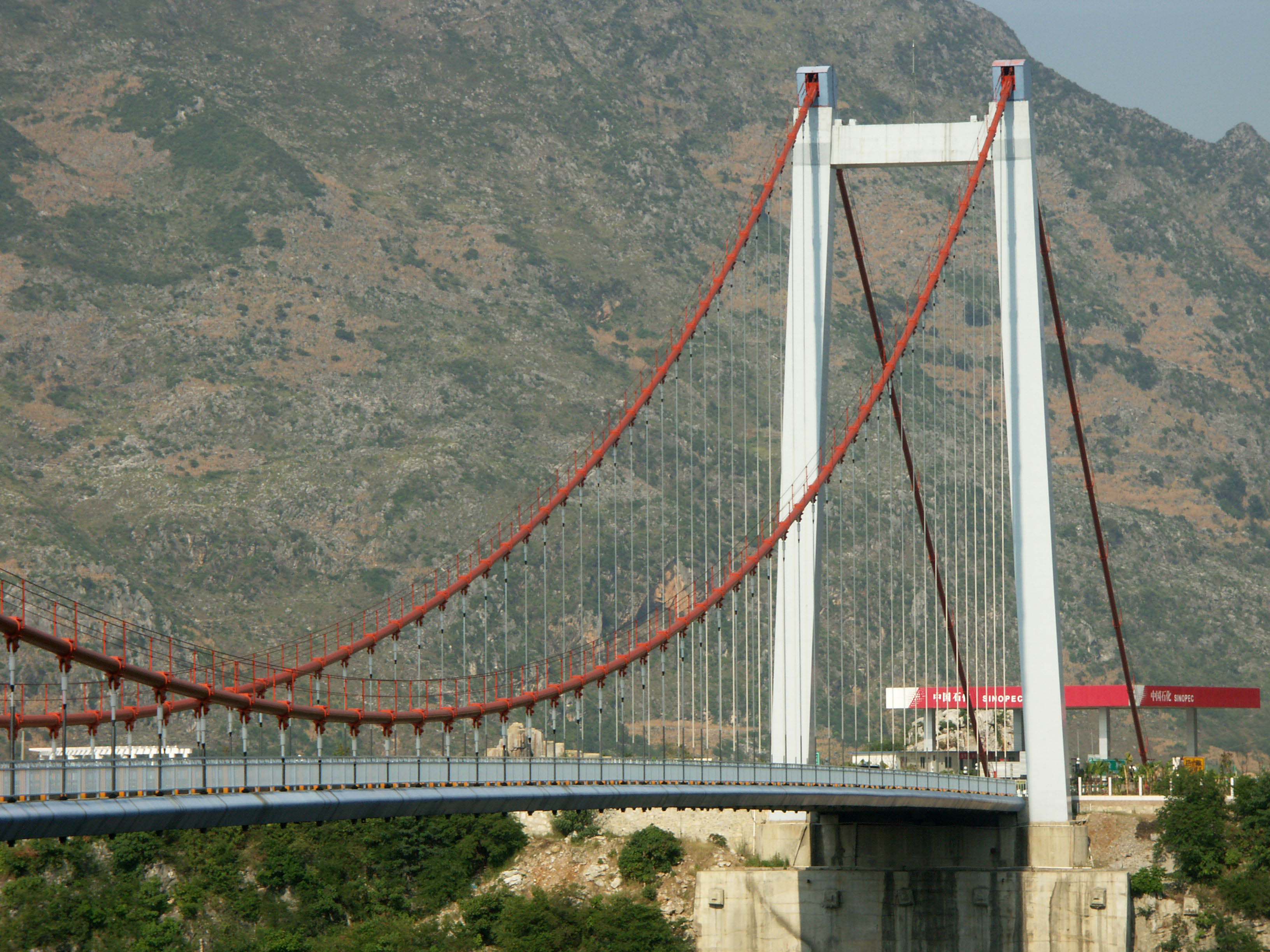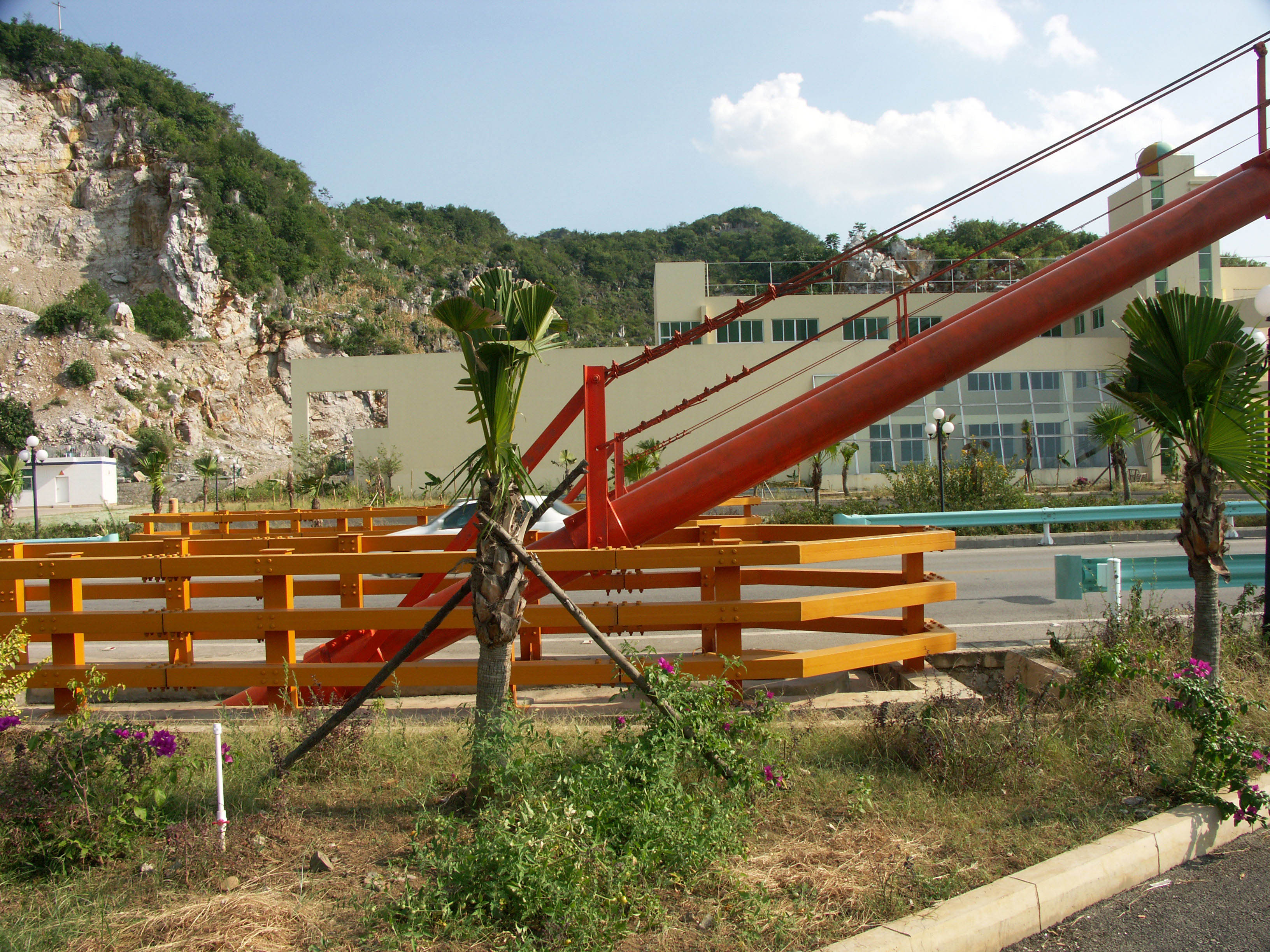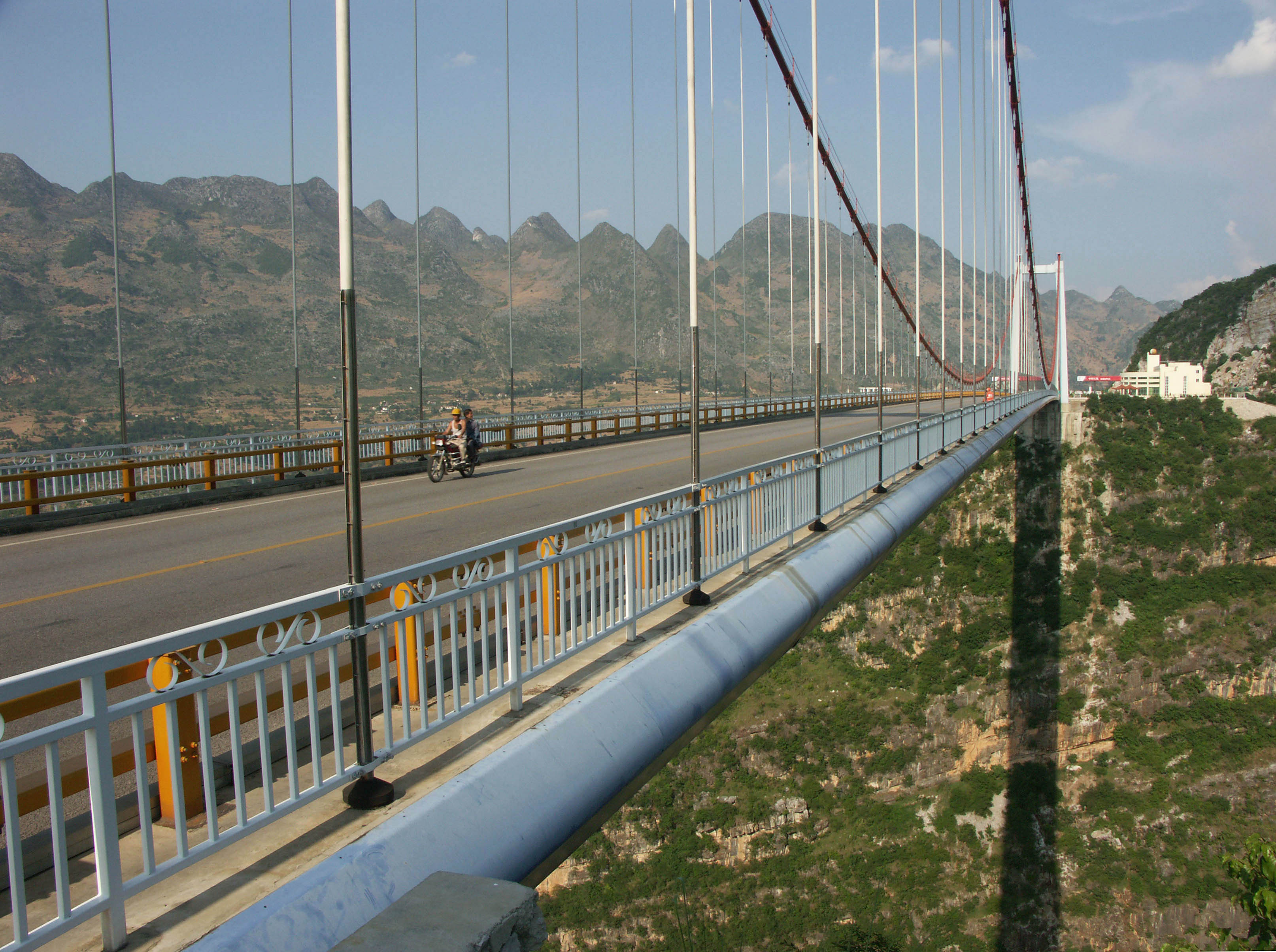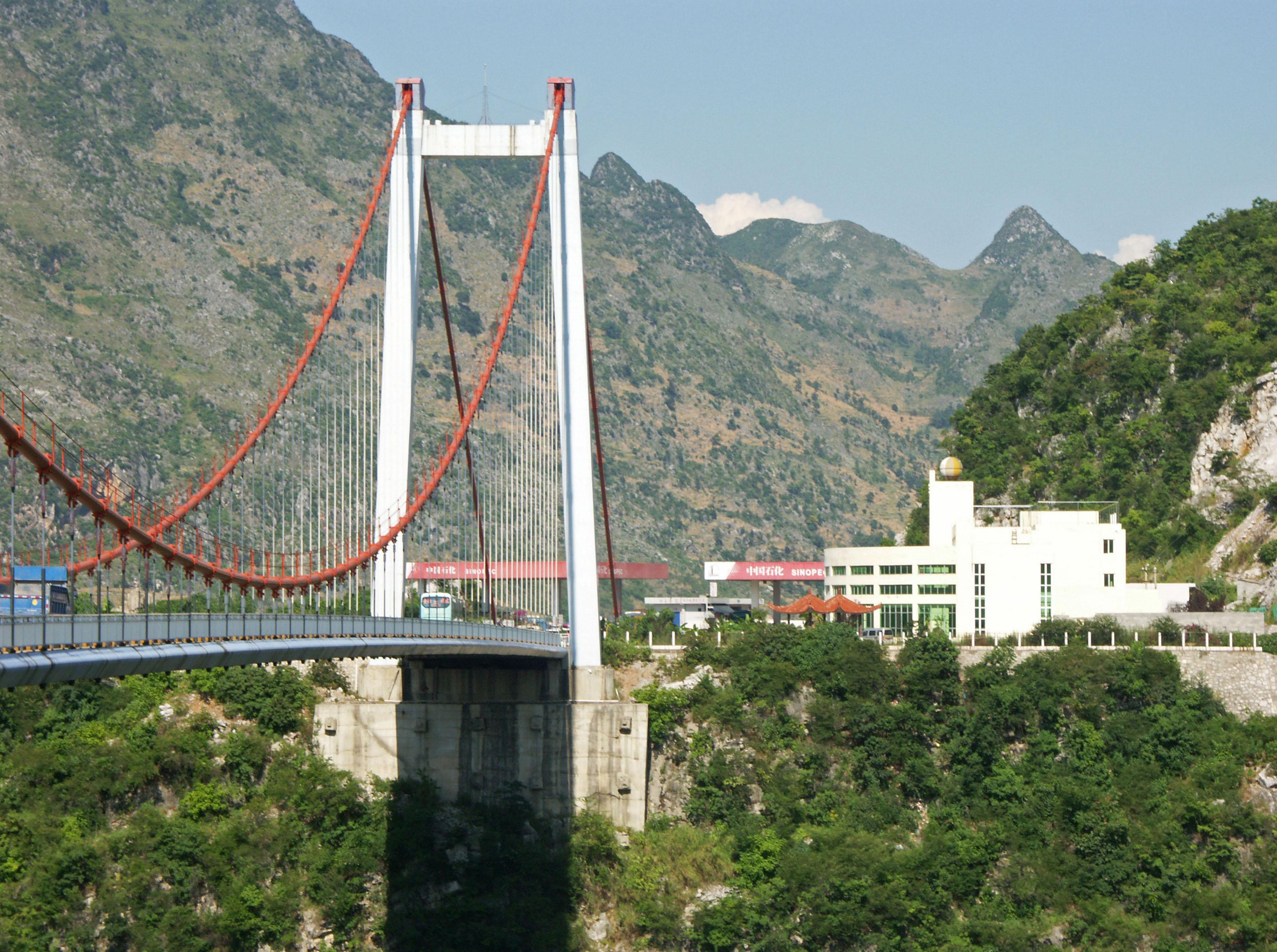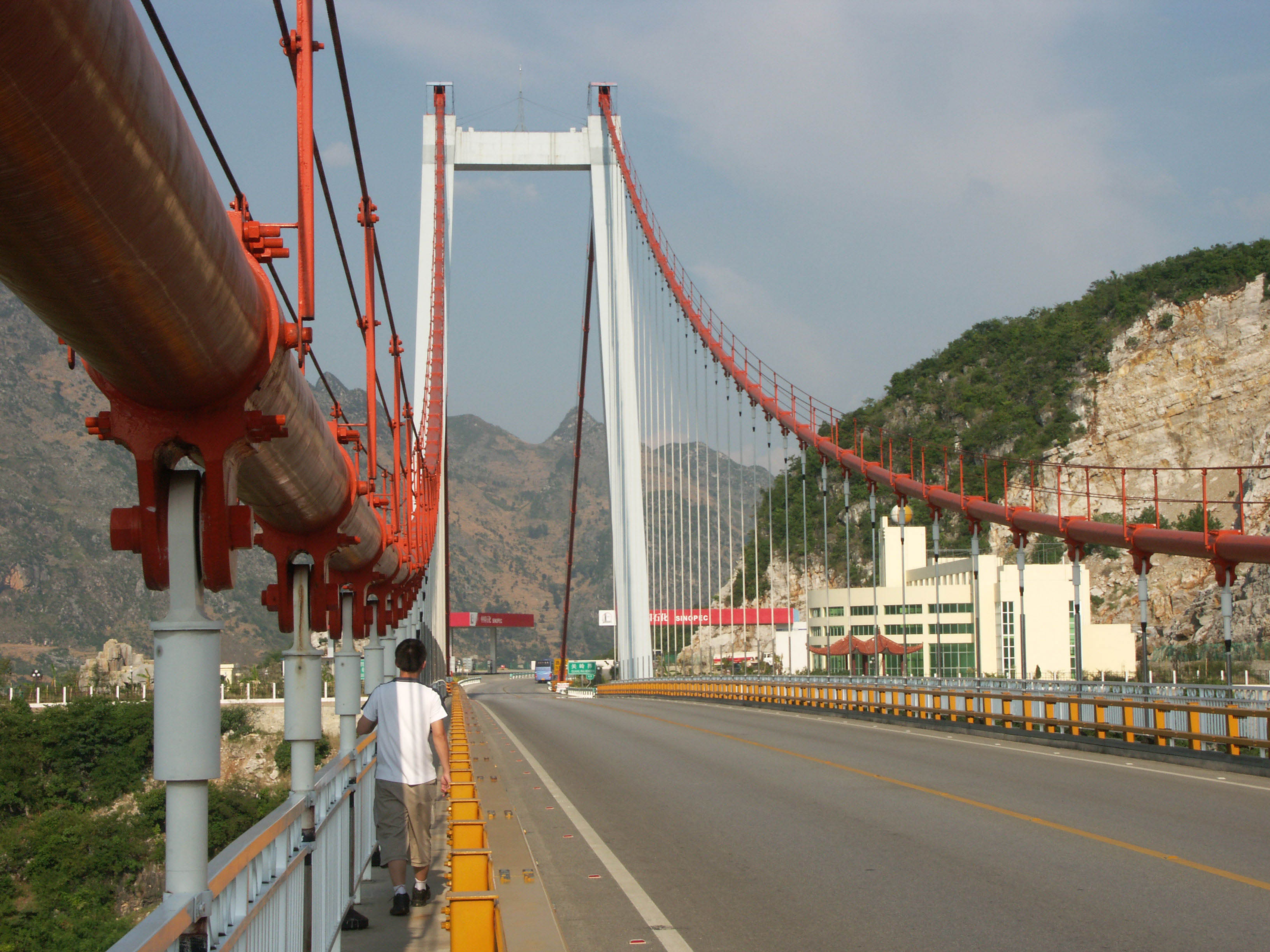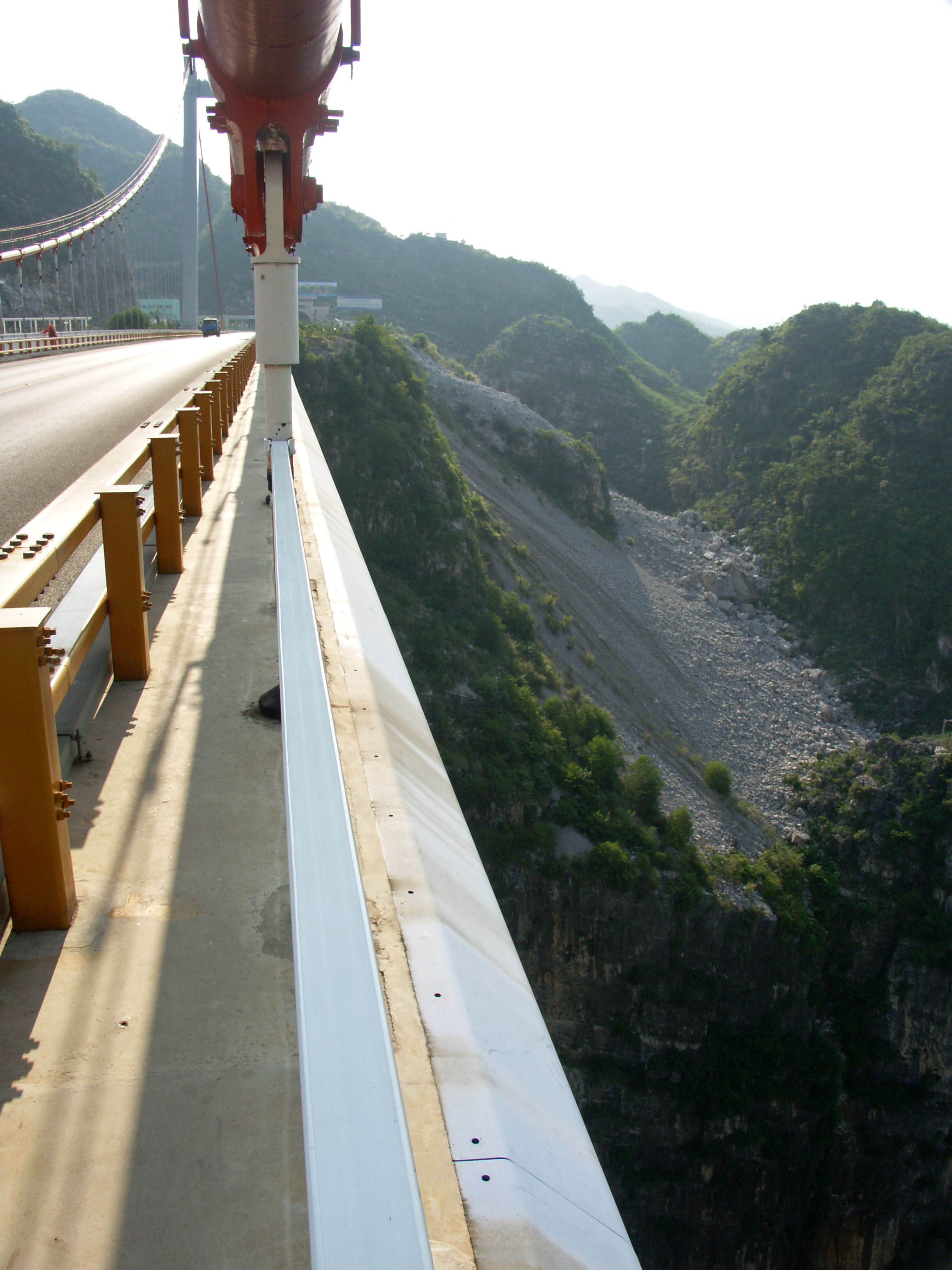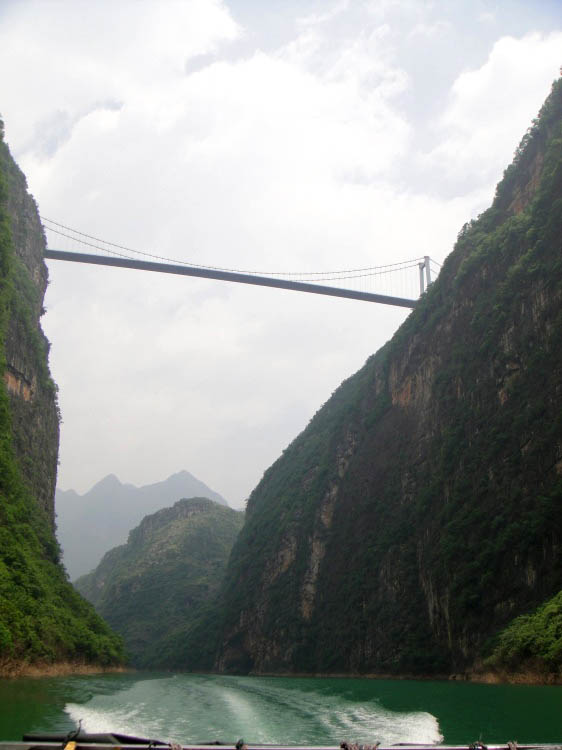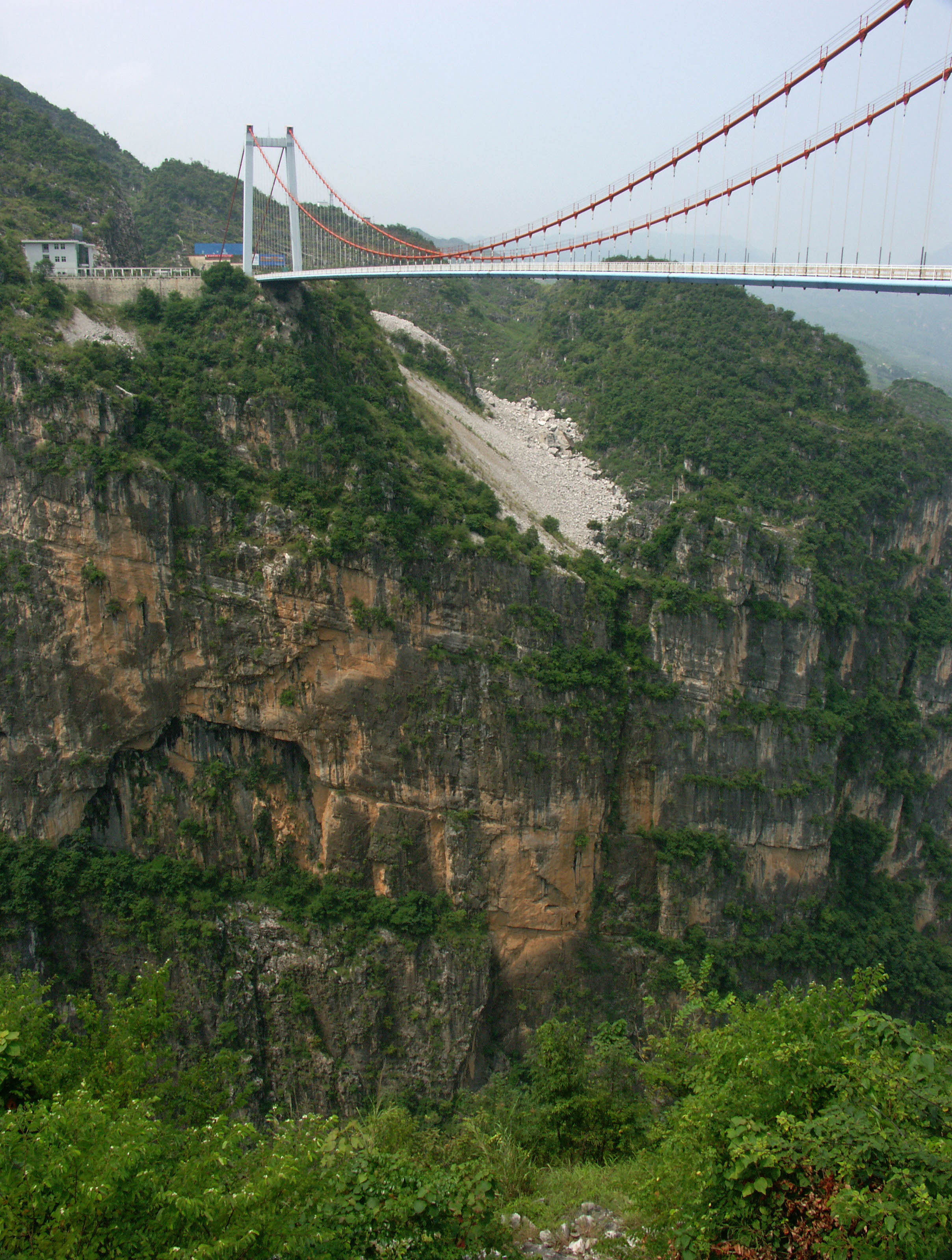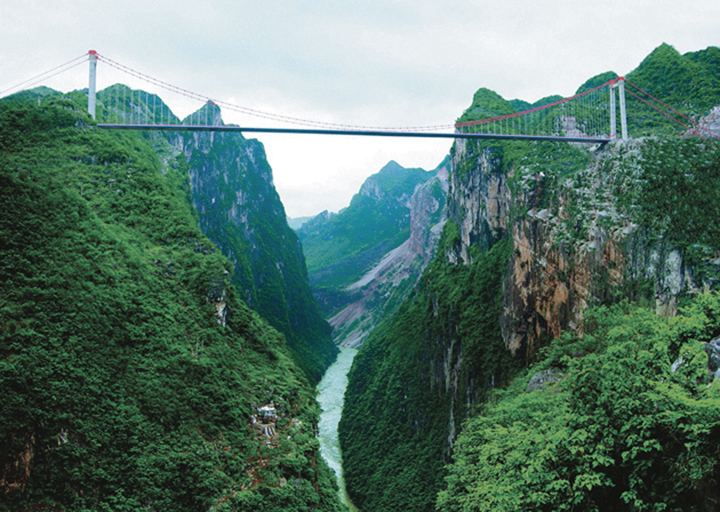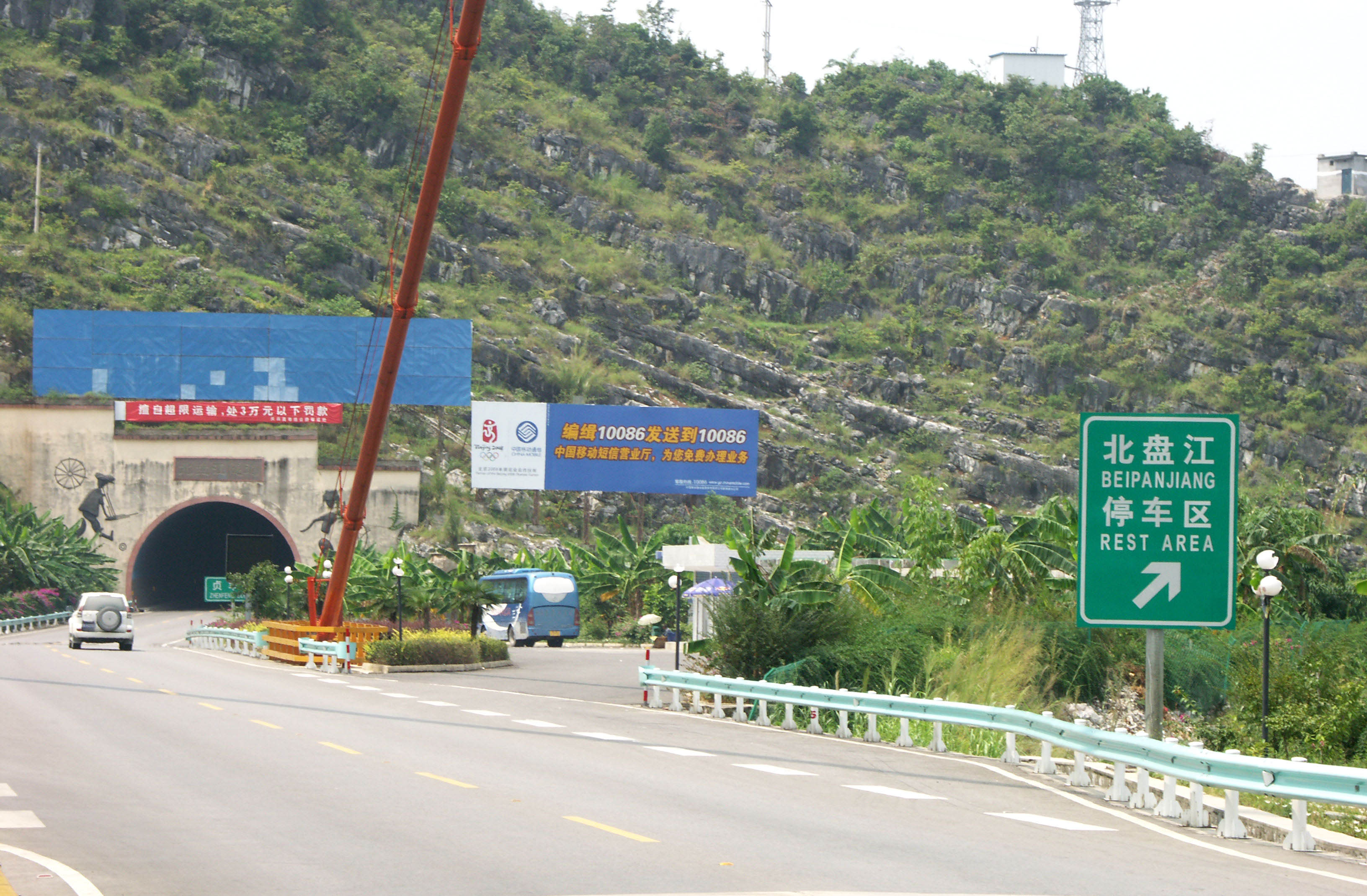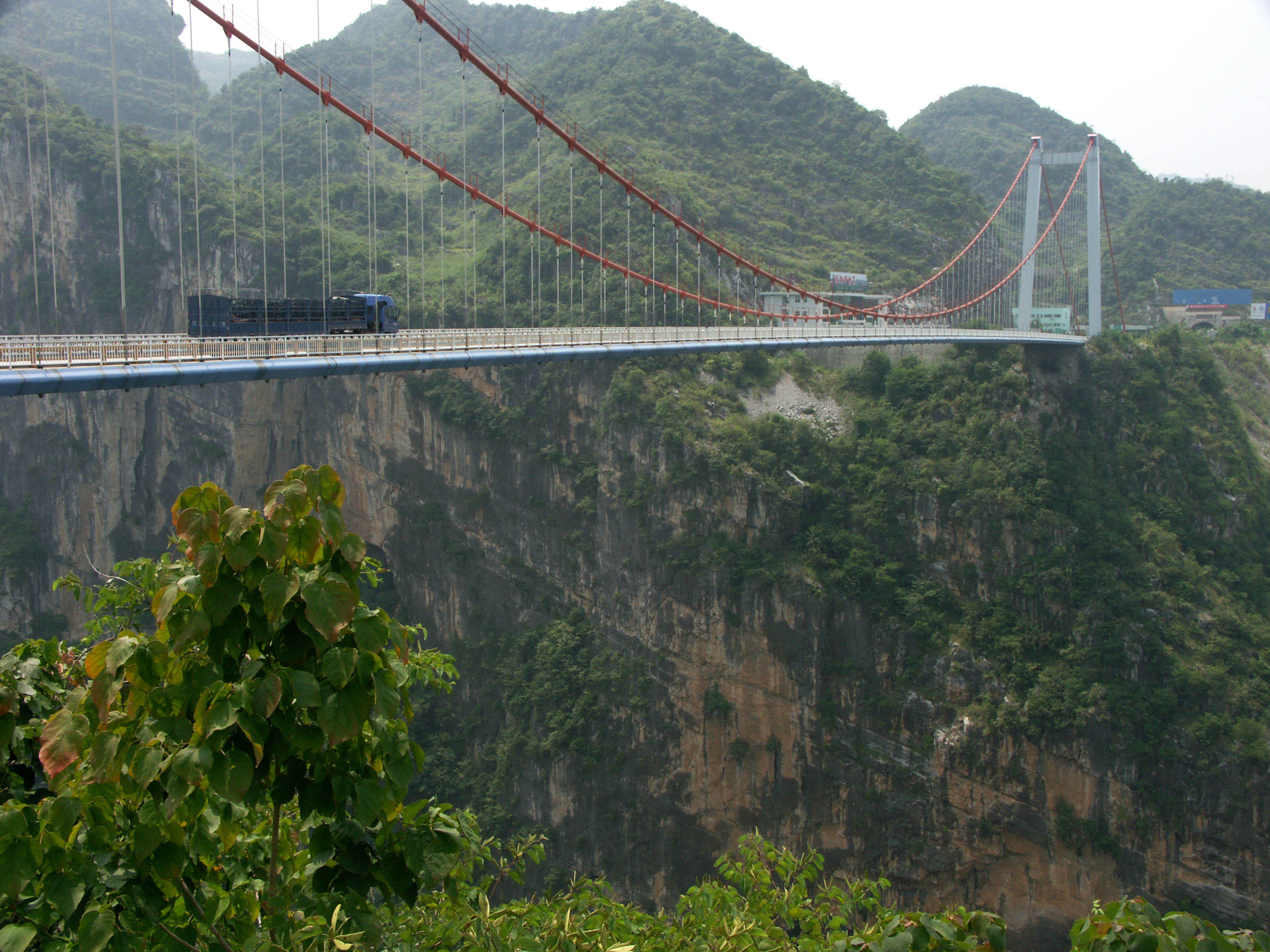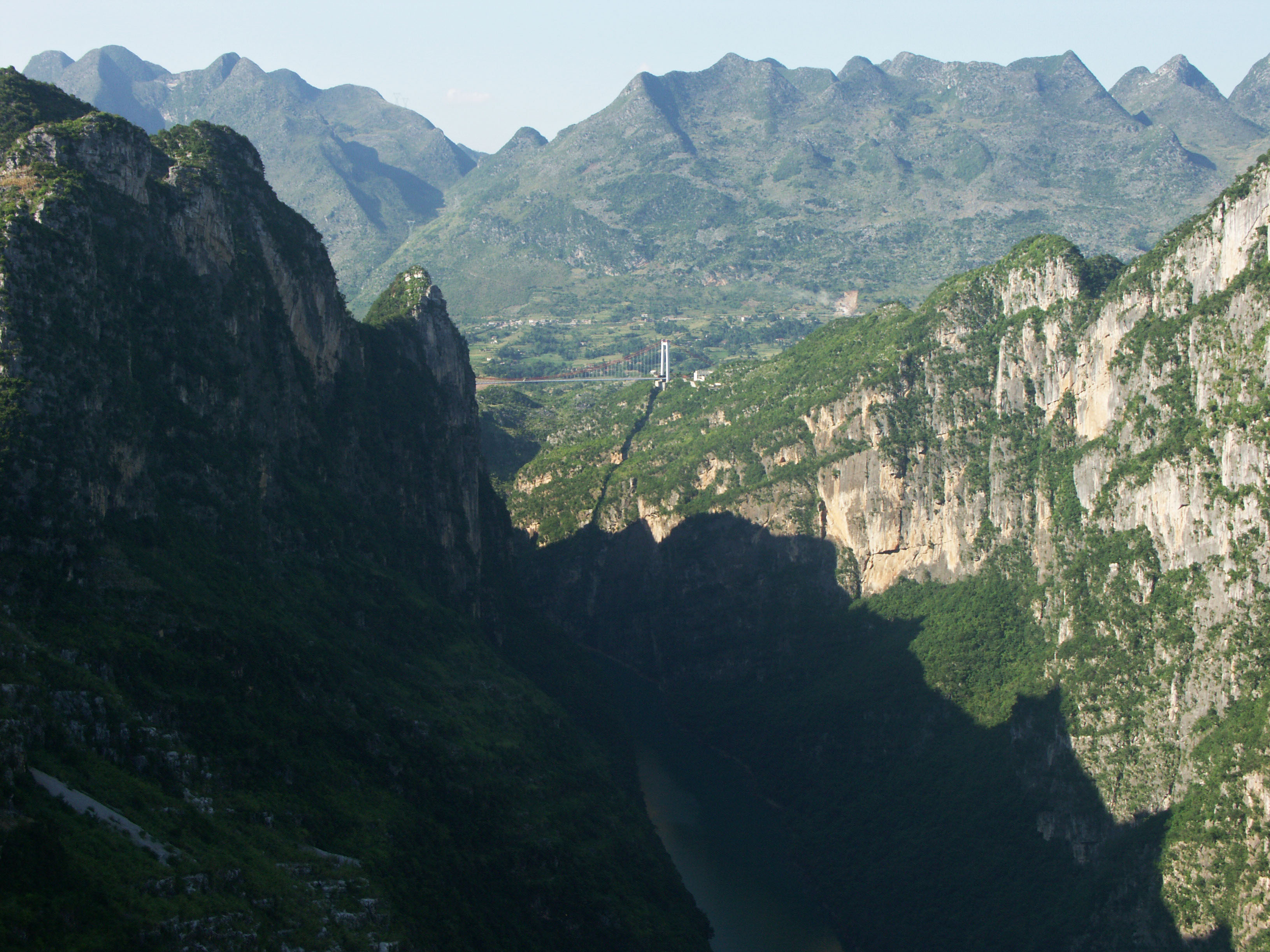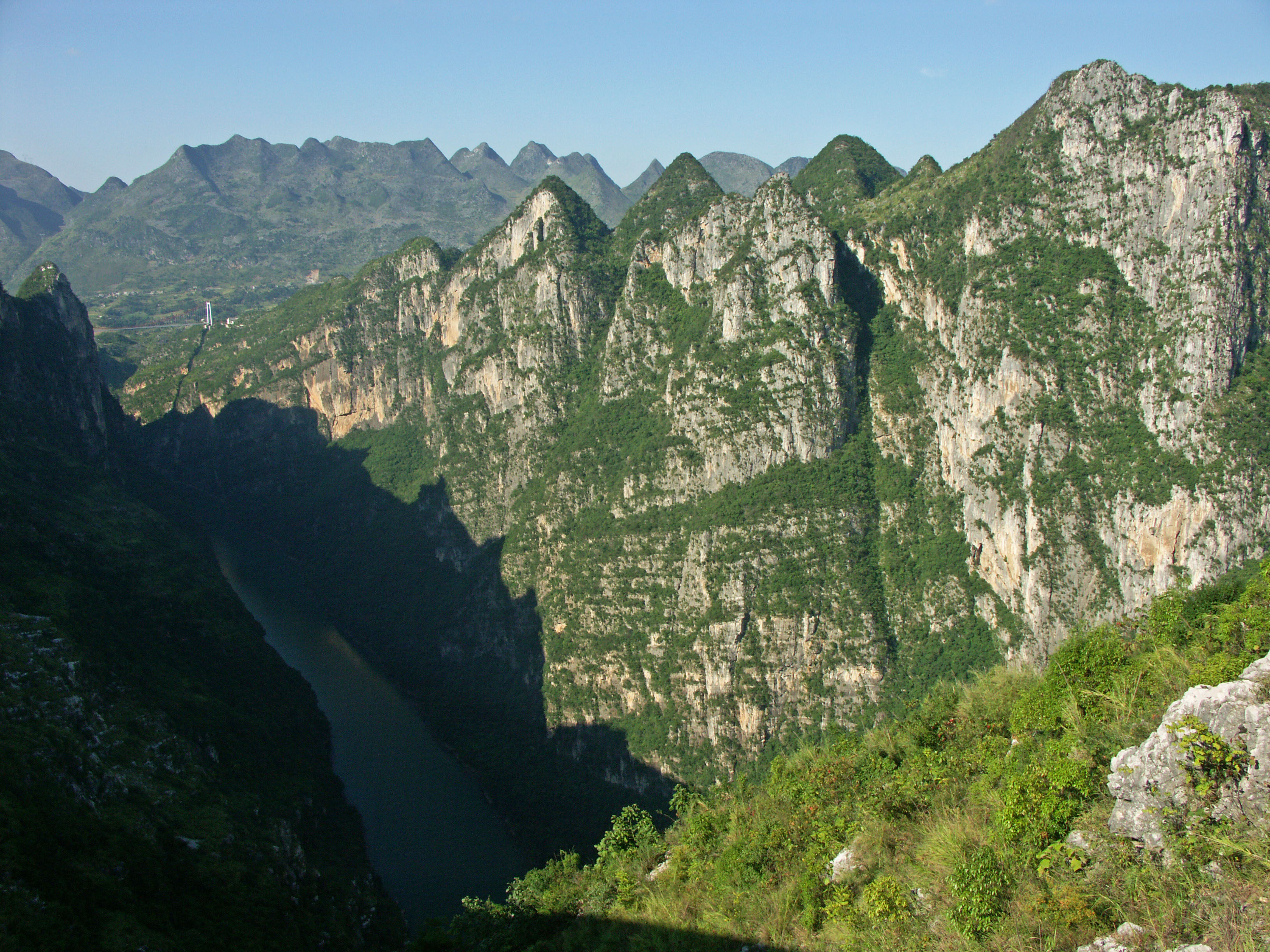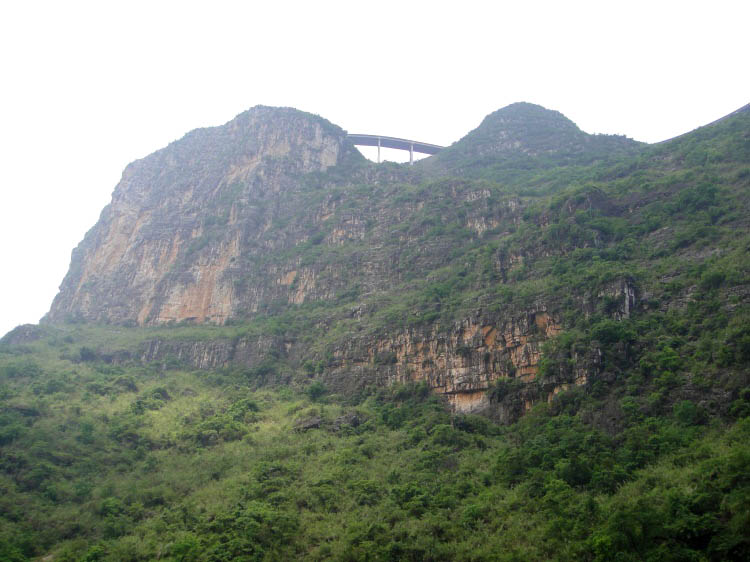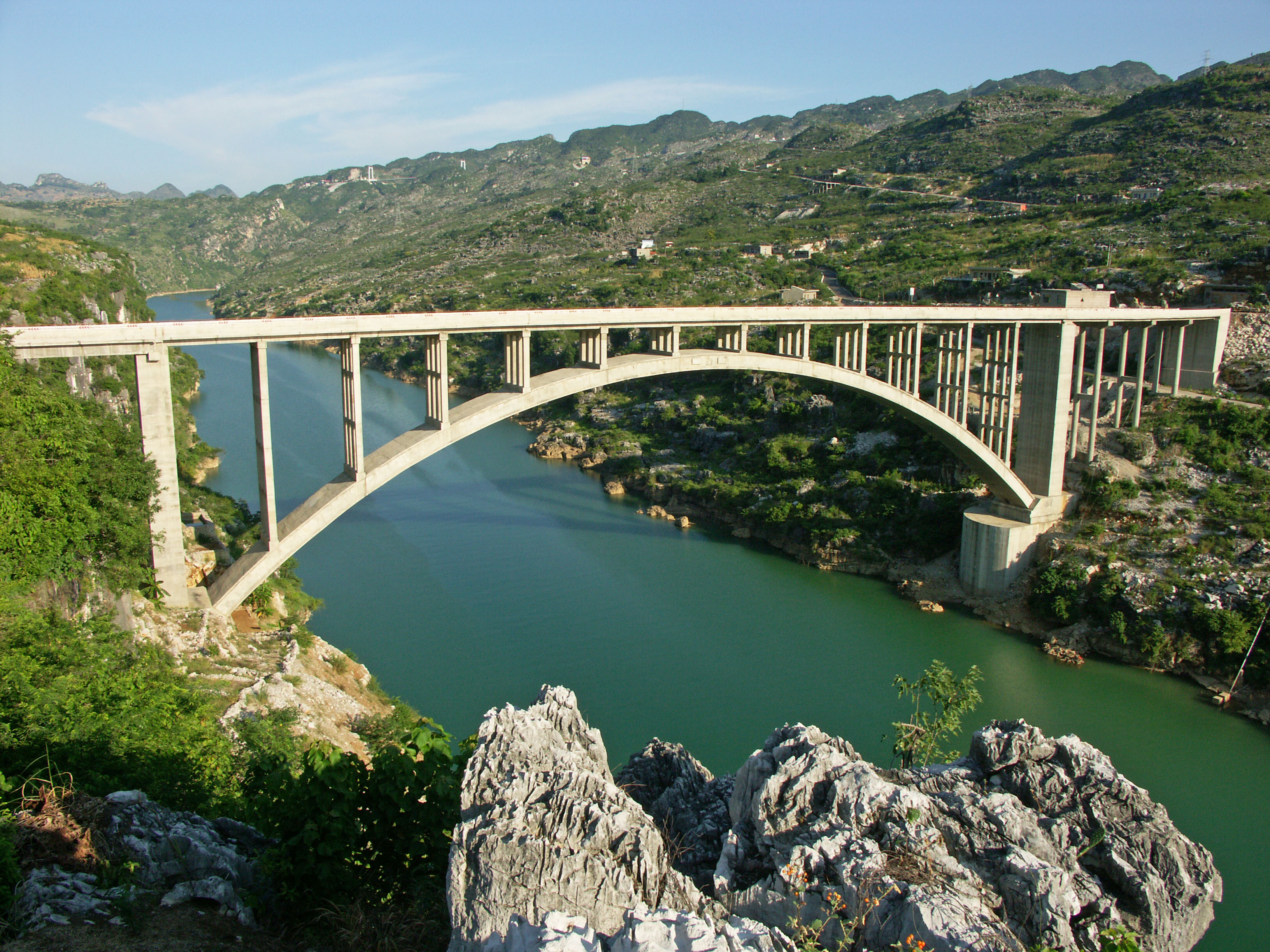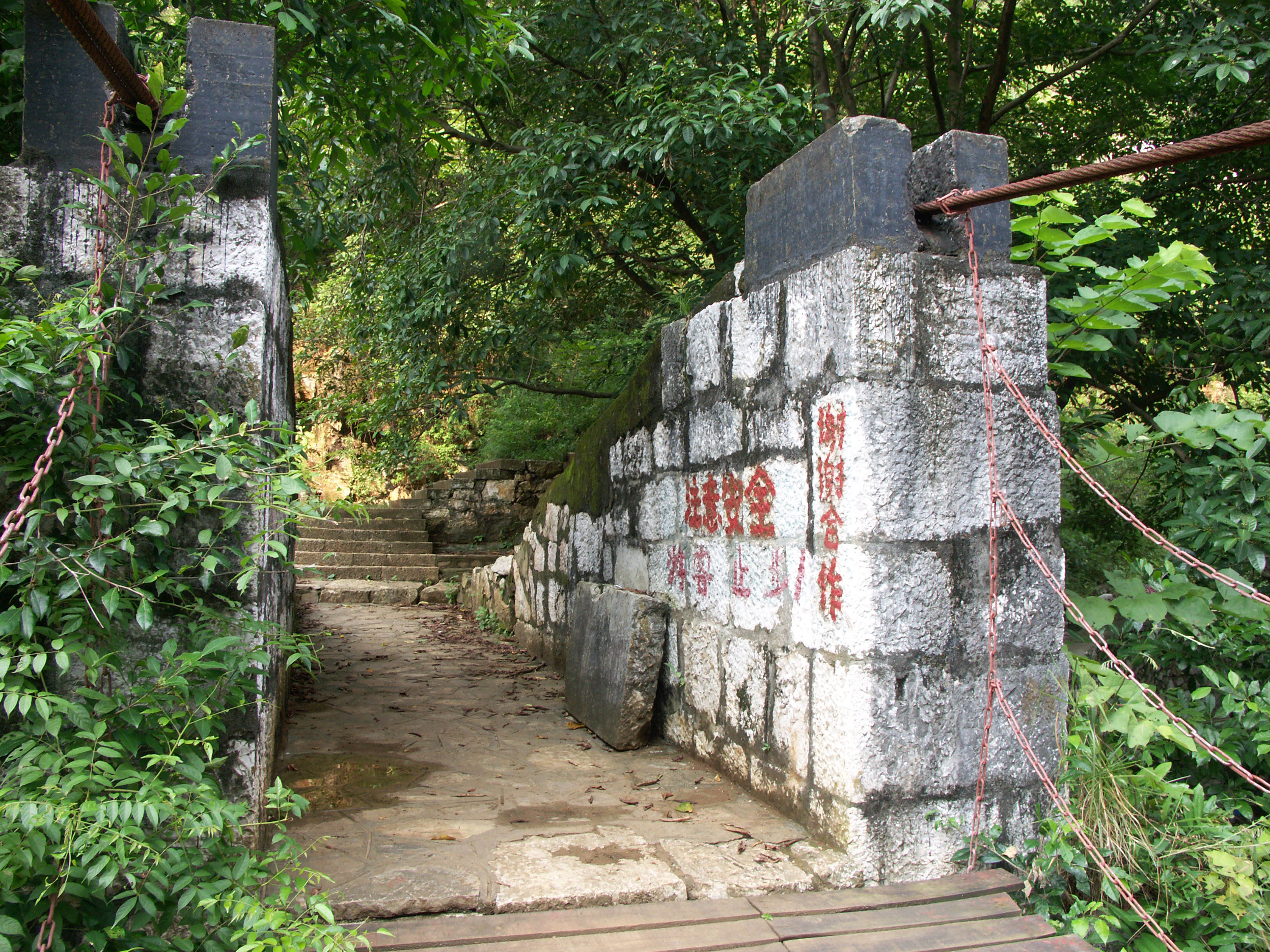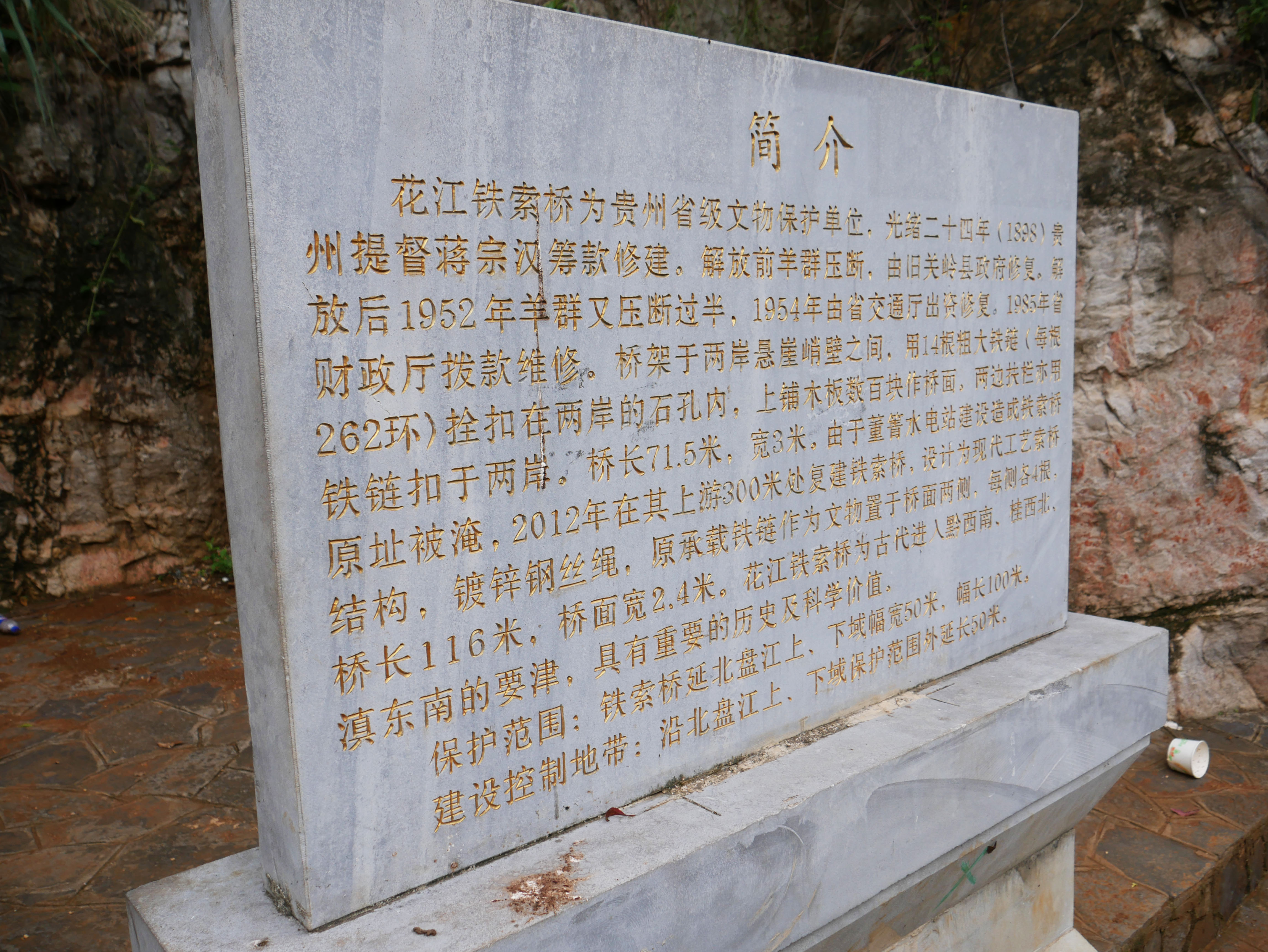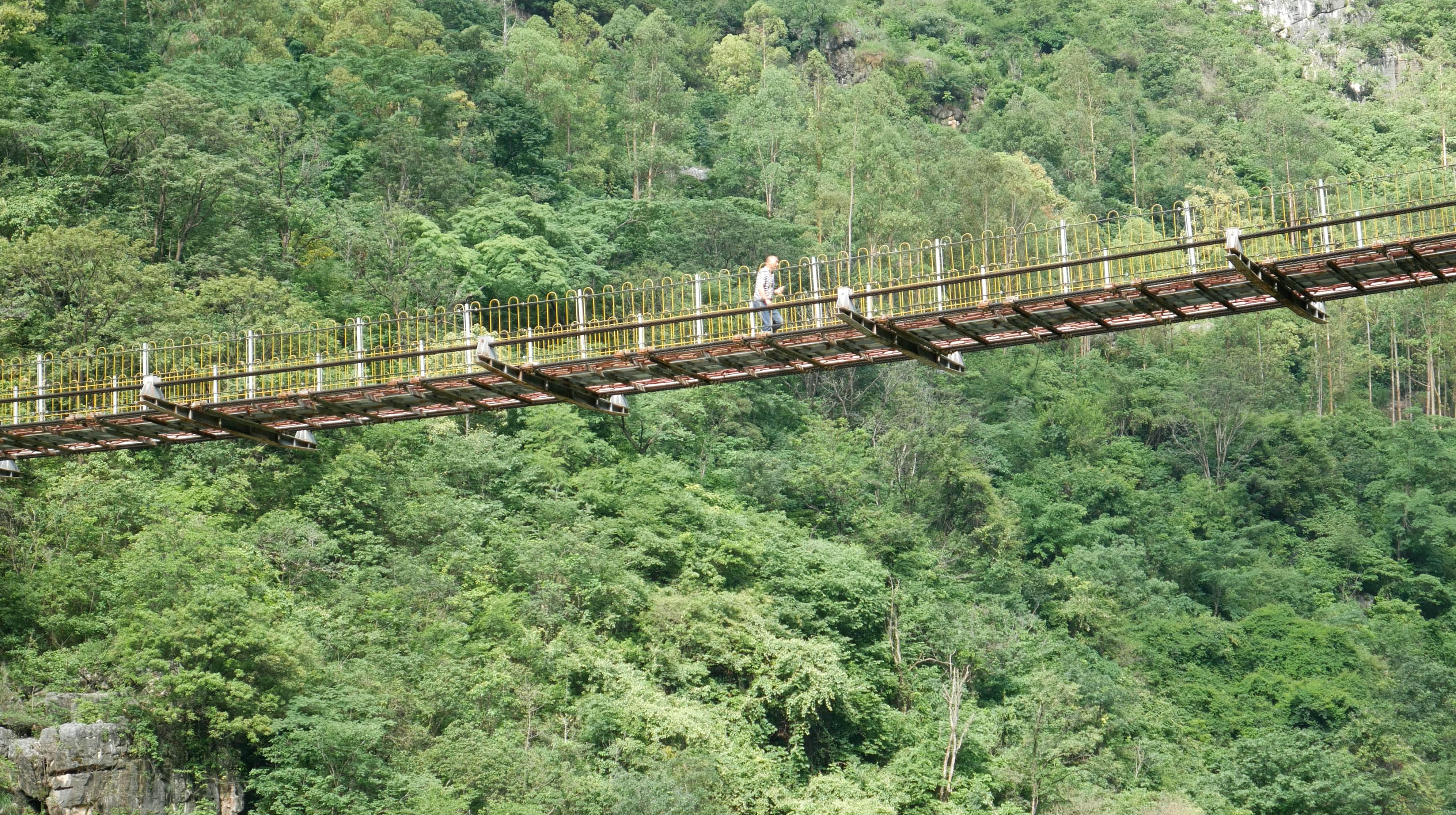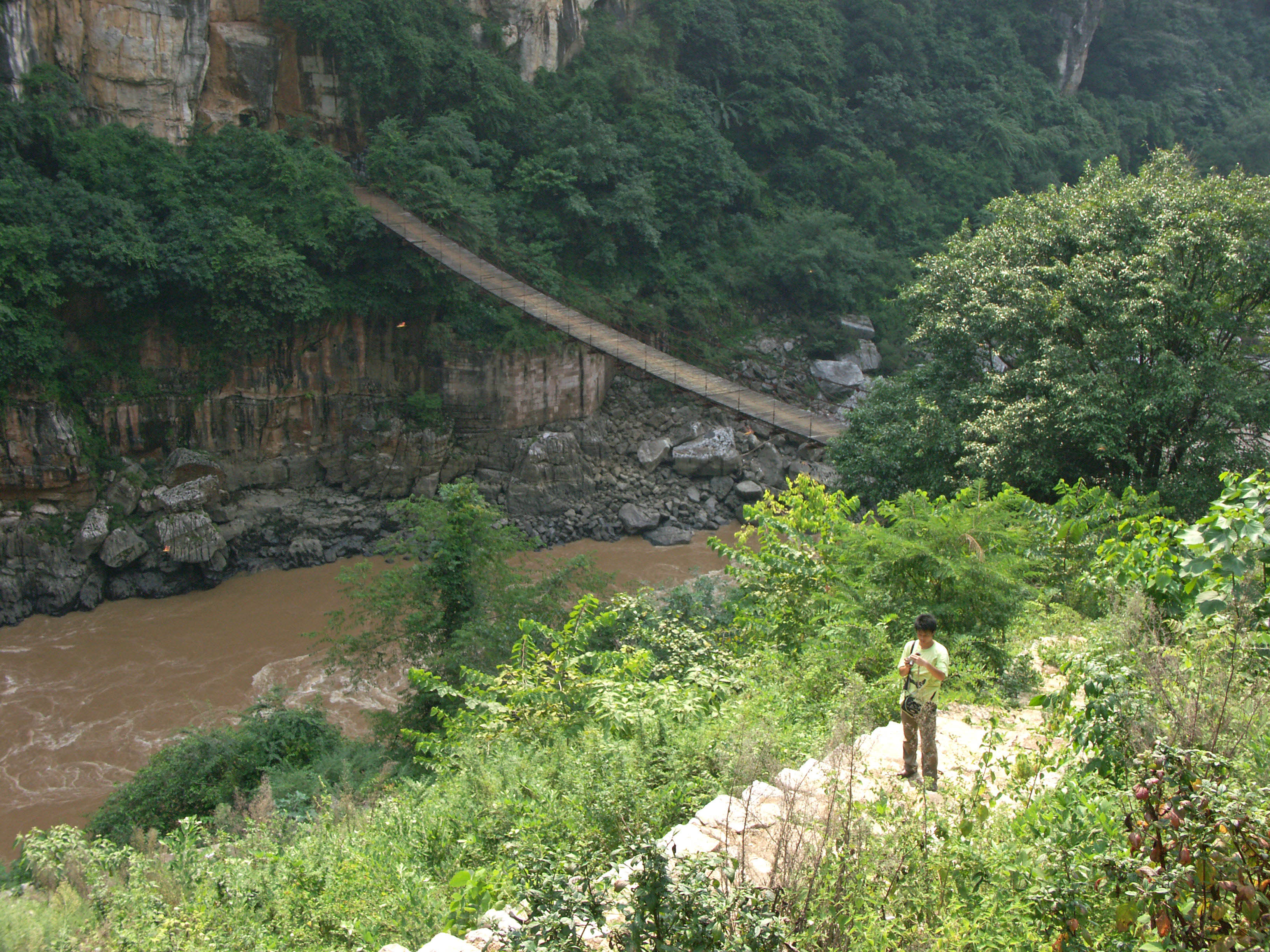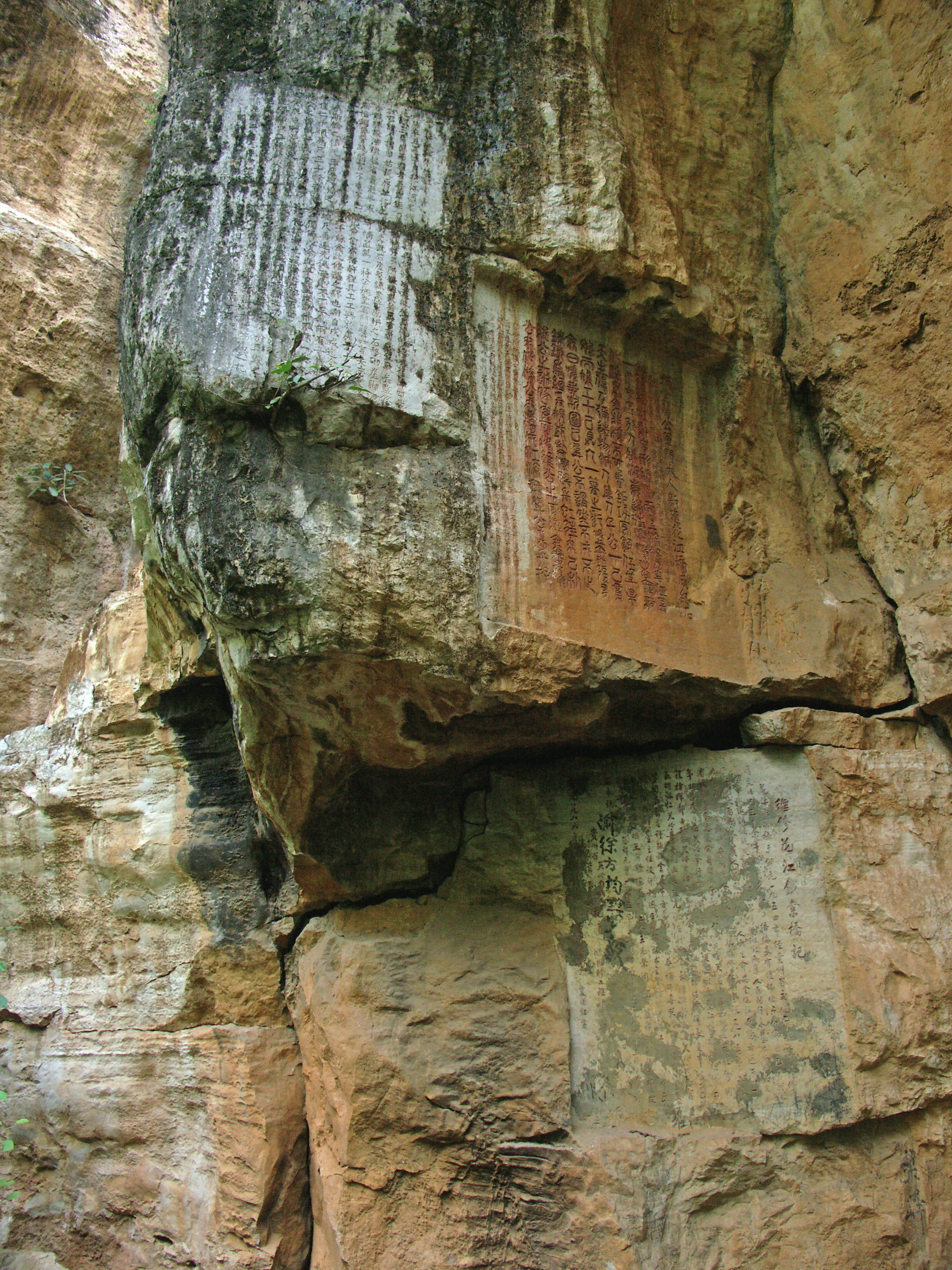Beipanjiang Bridge Guanxing
Beipanjiang Bridge Guanxing
关兴公路北盘江大桥
Xingbeizhen, Guizhou, China
1,200 feet high / 366 meters high
1,273 foot span / 388 meter span
2003
World's Highest Bridge 2003-2005
The highest bridge in the world upon its opening in late 2003, the 366 meter / 1,200 foot high Beipanjiang Bridge Guanxing became the second Chinese span in just two years to take this honor. The first was 2001’s Liuguanghe bridge. In addition, the Beipanjiang Guanxing became the first bridge to break the 1,000 foot and 300 meter height thresholds as well as the first suspension bridge in the world to surpass the height of Colorado’s Royal Gorge bridge after a 74-year reign. The bridge is also one of 4 Beipanjiang River crossings to have been among the world’s 10 highest. The first was the 902 foot high (275 meter) Beipanjiang Railway Bridge Shuibai which opened in 2001 and was the highest train bridge in the world until 2016 when it was surpassed by the Beipanjiang Qinglong and Najiehe Railway Bridges. The third bridge to cross high above the Beipanjiang opened in 2009 on the G60 Expressway with a suspension span 330 meters / 1,083 feet above the river. Then in 2016 the Beipanjiang Bridge Duge opened with a World Record deck height of 565 meters. Finally in 2025 the greatest crossing of all opened just 10 kms to the north in the form of the the Huajiang Grand Canyon Bridge with a deck height of 625 meters.
While not in the 300+ meter super-high category as these Beipan crossings, there are many other high bridges that have been built over the Beipan river gorge in more recent years including the Beipanjiang Shuipan Bridge, the Beipanjiang Bridge Wang’an expressway and the Beipanjiang Bridge Zhenfeng. Most of these bridges are spaced about 50 kms apart from each other. No other river on earth outside China has more than one or two high bridges over it - the Beipanjiang has 10 with more to come!
The word Beipanjiang (pronounced Bay-Pan-Gee-Ang) translates into North Winding River with the word “Bei” meaning north and “Pan” meaning winding. Cutting a huge swath from the northwest end of Guizhou Province to the southwest where it becomes the Hongshui he river at the border of Guangxi Province, the Beipanjiang River traverses through some of China’s most spectacular mountain gorges. When China began to expand its road and railway system in the 1990s, the river became the biggest obstacle between the city of Guiyang and the city of Kunming. The river also proved to be the biggest barrier between the mountain city of Xingyi and Guiyang. So when it was decided to build a modern two lane highway from Xingyi to the Guiyang highway, an extremely high and narrow bridge site was chosen near the town of Huajiang.
The Beipanjiang River bridge was one of 4 medium sized suspension bridges that were designed and built in the same time period by the Major Bridge Reconnaissance Design Institute in Wuhan, Hubei. The bridges all share common traits including an extremely thin 2 foot (.6 mtr) thick prestressed concrete slab deck and cable suspenders just 16 feet (5 mtrs) apart. Since all 4 bridges were of similar length and in similar gorge settings, it was economical and efficient to design them at the same time. The other 3 include the Azhihe, Xixi and Luojiaohe bridges. All four are among the world’s 100 highest bridges. One modification made to the Beipanjiang Guanxing that was not made to the other 3 spans was the addition of a curved wind breaker along the edge of the deck. Painted blue, it makes the bridge deck look even thinner and lighter than it already is.
The main cables have a span configuration of 103+388+103 meters with a cable sag ratio of 9:1. The main cables are .425 meters in diamter with 91 strands of parallel wires.
Despite its fall from the top spot among China’s highest spans, the Beipanjiang Bridge Guanxing is still one of the most vertigo inducing of all with cliffs that plummet into a void that seems to have no bottom. The cliff beneath the west side of the bridge is nearly vertical for 244 meters / 800 feet. The bridge is perfect for tourists with pedestrian friendly parking areas on both sides of the gorge as well as walkways along the edges of the span.
2003年后半年,随着当时世界最高的桥梁的通车,366米高的北盘江公路桥成为了两年之内第二座摘得世界最高大桥殊荣的悬索桥。第一个称为世界第一高的是2001年建成的六广河大桥。此外,北盘江大桥亦成为第一座突破了1000英尺和300米高大关的悬索桥,同时也是第一座超过世界上保存了74年纪录的科罗拉多州的皇家峡谷大桥的桥梁。这座大桥还是居于世界前十最高桥梁之列的三座北盘江桥之一。第一座建成的北盘江大桥是2001年建成通车的275米高的北盘江铁路桥,也是目前仍然世界第一高度铁路桥,这一记录得等到2015年印度的奇纳布河桥开通之后才会被刷新了。第三座北盘江大桥时2009年建成的贵阳至昆明高速公路上的330米高的悬索桥。
这三座北盘江大桥各自间距约50英里远,除了在中国,地球上没有任何一条河流上同时有三座很高的桥梁建成——仅仅只有北盘江,3座!如果这还不让人难以置信的话,规划中的昆明至毕节的公路干线上建有第四座跨越天堑的通道!并且紧邻北盘江铁路桥!
词语“北盘江”的意思,拆解开来是“曲曲折折盘在山岭间的大江的北段”。从贵州西北角发源,像一道深深的刀痕一样,北盘江一路蜿蜒直至贵州西南角,直至接近广西时成为了红水河,它横贯过了中国许多雄峻的山脉。在20世纪60年代时,中国决心开始拓展在贵阳和昆明之间的公路铁路系统建设时,北盘江成为了最大的困难艰险,它还是山城兴义和省会贵阳之间最大阻隔。因此,在兴建一条从兴义到贵阳的现代化双车道公路干线被决定之后,一个极其高而狭窄的桥址就被选择在了花江镇附近。
北盘江公路桥是同一时期设计、建成的四座中等跨径的悬索桥之一,由位于中国湖北武汉的中铁大桥局勘测设计院设计完成。这四座桥有一些共同特点,例如,桥面相当薄,仅为合0.6米厚的预应力混凝土桥面板,主缆吊杆的间距仅有5米。因为这四座桥桥长相近、而且桥址的峡谷环境也相似,所以一次性设计四座桥是比较经济和高效的,另三座桥分别为2003年建成的阿志河大桥、西溪大桥和落脚河大桥。这四座大桥都在世界前60最高的大桥范围之内。唯一一个没有在其他三座桥上实施的设计,是北盘江大桥(2003)的桥面板的边缘上添加了曲线形的风嘴。天蓝色的涂装,让桥面板看上去比实际更加的纤薄和轻盈。
尽管它已经从中国最高桥梁的至高点宝座退下,北盘江大桥(2003)仍然是最引起眩晕的桥梁,边上就是陡坠向下直至看似无底的空虚里悬崖峭壁。西侧桥下的岩壁几乎垂直向下244米。世界上再也没有其他如此一般的深渊之上架桥了。就是这道狭窄的深壑,也有着唯一特征使得北盘江大桥称为世界上第一个“10秒桥梁”。你也许会问,那是什么啊?就是说,北盘江大桥是如此之高以至于一个物体桥面上自由落体而下,至少10秒以上才能触及江面。大桥是个绝佳的旅游去处,桥面上有人行道,桥两头还有很宽阔的停车服务区,可以让游人一直到达大桥边缘。
Image by Chen7224255.
A view of the east side bridge tower. Image by Eric Sakowski / HighestBridges.com
Looking north over the deep chasm of the Beipan River gorge in 2008 before the reservoir filled up beneath the span. Image by Eric Sakowski / HighestBridges.com
A view in 2011 shows the nearly full reservoir that reduced the bridge deck height by approximately 150 feet (46 meters).Image by Eric Sakowski / HighestBridges.com
The underside of the bridge showing the extremely thin 2 foot (.6 mtr) thick prestressed concrete slab deck. Image by Eric Sakowski / HighestBridges.com
Image by Eric Sakowski / HighestBridges.com
A worker keeps the barriers and hand rails clean. Image by Eric Sakowski / HighestBridges.com
Image by Eric Sakowski / HighestBridges.com
Image by Eric Sakowski / HighestBridges.com
Image by Eric Sakowski / HighestBridges.com
The extremely thin 2 foot (.6 mtr) thick prestressed concrete slab deck sections can be seen in this 2003 construction view.
Image by Eric Sakowski / HighestBridges.com
The Beipanjiang Bridge in 2008 before the reservoir. Image by Eric Sakowski / HighestBridges.com
A similar view in 2011 with the 150 foot (46 meters) deep reservoir. Image by Eric Sakowski / HighestBridges.com
Interpreter Ian Chen with the 2008 Beipan River beyond. Image by Eric Sakowski / HighestBridges.com
A 2011 view with Georges of France and the Beipan reservoir. Image by Eric Sakowski / HighestBridges.com
Image by Eric Sakowski / HighestBridges.com
The Beipanjiang 2003 Bridge soon after it was completed.
Image by Eric Sakowski / HighestBridges.com
Image by Eric Sakowski / HighestBridges.com
Image by Eric Sakowski / HighestBridges.com
Image by Eric Sakowski / HighestBridges.com
Image by Eric Sakowski / HighestBridges.com
Image by Eric Sakowski / HighestBridges.com
Image by Eric Sakowski / HighestBridges.com
Image by Eric Sakowski / HighestBridges.com
Image by Eric Sakowski / HighestBridges.com
Image by Eric Sakowski / HighestBridges.com
A little village of food stalls formed on the northeast side of the bridge since my earlier visits in 2006 and 2008.Image by Eric Sakowski / HighestBridges.com
Image by Eric Sakowski / HighestBridges.com
Image by Eric Sakowski / HighestBridges.com
A view of the Beipan River - 1,200 feet straight down in 2006. Image by Eric Sakowski / HighestBridges.com
Another view of the Beipan in 2011. Image by Eric Sakowski / HighestBridges.com
Looking south through the magnificent Beipanjiang River gorge.
Image by Eric Sakowski / HighestBridges.com
Beipan River gorge in 2008. Image by Eric Sakowski / HighestBridges.com
Beipan River gorge in 2011 with the new reservoir. Image by Eric Sakowski / HighestBridges.com
Image by Eric Sakowski / HighestBridges.com
This 2006 view shows the vertical limestone cliffs that are typical of the mountains in Guizhou Province. Image by Eric Sakowski / HighestBridges.com
A view of the Beipan River in 2011. Image by Eric Sakowski / HighestBridges.com
Image by Eric Sakowski / HighestBridges.com
Food vendors serve snacks and drinks on the southeast side in this 2006 view. An entire vendor village had formed on the northeast side in 2011. Image by Eric Sakowski / HighestBridges.com
There are many tunnels along the highway on both sides of the bridge. Image by Eric Sakowski / HighestBridges.com
Image by Eric Sakowski / HighestBridges.com
Image by Georges.
Image by Eric Sakowski / HighestBridges.com
Image by Eric Sakowski / HighestBridges.com
A 2006 view before the reservoir formed. Image by Eric Sakowski / HighestBridges.com
A 2011 view with the reservoir beneath the span. Image by Eric Sakowski / HighestBridges.com
The highway continues to gain elevation as it heads west to Xingyi in this 2006 view. Image by Eric Sakowski / HighestBridges.com
A view from 2011.Image by Eric Sakowski / HighestBridges.com
Image by Eric Sakowski / HighestBridges.com
The elevated viaducts from which the previous images were taken are more then 400 meters above the river.
Image by www.anshun.gov.cn
Sometime in 2009, a reservoir formed beneath the bridge from a downstream dam.
Large highway signs showing big local bridges are a common site throughout China. Image by Eric Sakowski / HighestBridges.com
A satellite view from around the year 2000 shows the new highway under construction with the Beipanjiang bridge crossing in the center.
A view of the Beipanjiang River gorge about 2 miles (3 kms) upstream of the bridge. You can faintly see the suspension bridge towers in the upper right. The footbridge you see in the foreground is for the construction of a new arch bridge that bypassed the stone arch bridge from 1961. This bypass was necessary as a dam was completed in 2009 and flooded the river valley beneath a deep reservoir. Image by Eric Sakowski / HighestBridges.com
The older road to Huajiang crossed the Beipanjiang River on this stone arch bridge from 1961. The bridge was finally closed sometime in 2010 when a new concrete arch bypassed it with a main span of 459 feet (140 meters). Image by Eric Sakowski / HighestBridges.com
The replacement arch was constructed by forming the two halves of the arch on falsework built high up along the hillside. The two halves were then rotated out over the river on August 24th of 2009. The Chinese are the only bridge builders in the world that still use this innovative technique.
The two arch halves are held back by cables that pass through the concrete pier and down to the base.
The massive concrete piers are slowly rotated using an old fashioned pulley system.
Image by Eric Sakowski / HighestBridges.com
Image by Eric Sakowski / HighestBridges.com
Image by Eric Sakowski / HighestBridges.com
Image by Eric Sakowski / HighestBridges.com
Image by Eric Sakowski / HighestBridges.com
Image by Eric Sakowski / HighestBridges.com
Image by Eric Sakowski / HighestBridges.com
The suspension bridge can just barely be seen from the new concrete arch crossing. Image by Eric Sakowski / HighestBridges.com
Image by Eric Sakowski / HighestBridges.com
Image by Eric Sakowski / HighestBridges.com
Image by Eric Sakowski / HighestBridges.com
A trek to the Beipanjiang River gorge would not be complete without a visit to the original 1898-built chain suspension bridge near Huajiang. This unusual type of catenary suspension bridge is unique to China.
This footbridge was removed sometime around 2009 when a downstream dam required it to be rebuilt a few hundred meters upstream at a higher level above the reservoir.
The original main span measured 65 meters while the new Huajiang chain footbridge has a span of 70 meters. You can drive down to the footbridge from the west side or hike down over 100 meters from a parking area on the east side. The most famous of China's classic chain suspension spans is the Luding bridge in Sichuan Province.
Hopefully this classic chain bridge will survive for generations to come. Image by Eric Sakowski / HighestBridges.com
Image by Eric Sakowski / HighestBridges.com
Image by Eric Sakowski / HighestBridges.com
Image by Eric Sakowski / HighestBridges.com
Image by Eric Sakowski / HighestBridges.com
Image by Eric Sakowski / HighestBridges.com
Image by Eric Sakowski / HighestBridges.com
Image by Eric Sakowski / HighestBridges.com
Image by Eric Sakowski / HighestBridges.com
The new Huajiang Chain Bridge. Image by Eric Sakowski / HighestBridges.com
Image by Eric Sakowski / HighestBridges.com
Image by Eric Sakowski / HighestBridges.com
Image by Eric Sakowski / HighestBridges.com
Image by Eric Sakowski / HighestBridges.com
Image by Eric Sakowski / HighestBridges.com
Image by Eric Sakowski / HighestBridges.com
Image by Eric Sakowski / HighestBridges.com
Image by Eric Sakowski / HighestBridges.com
Image by Eric Sakowski / HighestBridges.com
Image by Eric Sakowski / HighestBridges.com
Image by Eric Sakowski / HighestBridges.com
Image by Eric Sakowski / HighestBridges.com
Image by Eric Sakowski / HighestBridges.com
Image by Eric Sakowski / HighestBridges.com
Image by Eric Sakowski / HighestBridges.com
Image by Eric Sakowski / HighestBridges.com
Image by Eric Sakowski / HighestBridges.com
Image by Eric Sakowski / HighestBridges.com
Image by Eric Sakowski / HighestBridges.com
Image by Eric Sakowski / HighestBridges.com
The chains are mostly hidden beneath the deck planks on this view of the old span. Image by Eric Sakowski / HighestBridges.com
Image by Eric Sakowski / HighestBridges.com
Beautiful writings were carved into the cliffs at the far end of the bridge. Image by Eric Sakowski / HighestBridges.com
Image by Eric Sakowski / HighestBridges.com
Image by Eric Sakowski / HighestBridges.com
Image by Eric Sakowski / HighestBridges.com
Image by Eric Sakowski / HighestBridges.com
The chain bridge had become somewhat dilapidated after the reservoir formed beneath it in 2009.
Beipanjiang Bridge Guanxing satellite image.
Beipanjiang Bridge Guanxing location map.









